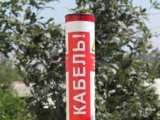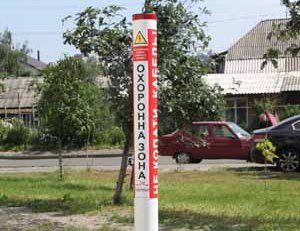Checking the cable lines
 Inspection of the route of the cable line is carried out in order to visually detect possible faults along the route. During the inspection, attention is paid to the inadmissibility of production without the consent of the electrical network of construction works, excavations, planting trees, arrangement of garages, warehouses, dumps with the enterprise.
Inspection of the route of the cable line is carried out in order to visually detect possible faults along the route. During the inspection, attention is paid to the inadmissibility of production without the consent of the electrical network of construction works, excavations, planting trees, arrangement of garages, warehouses, dumps with the enterprise.
When inspecting the intersections of cable routes with railway lines, attention is paid to the presence of warning posters for the location of cable lines on both sides of the railway ROW.
When crossing cable lines with ditches, ditches, ravines, it is checked whether there is no erosion, damage and collapse of the fastening elements of the ditch, which threaten the integrity and safety of the cables. In places where the cables pass from the ground and on walls or supports of overhead power lines, the presence of protection of the cables from mechanical damage and the operability of the end connectors are checked.
On the routes of cable lines passing through territories without permanent fundamental landmarks, the presence and safety of towers that determine the route of the cable line are checked.
In places where the cables pass from the shores to a river or other bodies of water, the presence and condition of coastal signal signs and the serviceability of embankments or special devices along the coastal sections are checked. When inspecting cable wells, check air temperature and operation of ventilation devices.
In summer, the air temperature in cable tunnels and channels should not exceed the outside air temperature by more than 10 C. When examining, pay attention to the external condition of the cable, connectors and end connectors, the construction part of structures, to mix and sag cables. The temperature of the cable sheaths is checked using measuring devices.
The temperature of the metal sheaths of cables laid in cable structures is measured with a conventional thermometer that is attached to the armor or lead sheath of the cable. Temperature control of the cable line is necessary to establish the fact of an increase in the load compared to the calculated or to clarify the load due to changes in the temperature conditions of the cable route compared to the design ones.
Defects found on the routes and in the cable lines themselves must be eliminated both during the inspection and subsequently in a planned manner.

During the technical supervision of the work carried out along the route of the cable line, it is necessary to ensure that the landing of earth-moving machines at a distance of less than 1 m from the cable and loosening of the soil above the cable with hammers at a depth of more than 0 ,4 m is not carried out.
When using shock and vibration diving mechanisms at a distance of less than 5 m from the route of the cable line, ground shaking and soil collapse are possible, as a result of which the cable cores can be pulled out of the connecting sleeves in the connectors and the lead or the aluminum sheath of the cable in the throat of the connectors may break. Therefore, the use of these mechanisms at a distance of less than 5 m from the route of the cable line is not allowed. In winter, excavation work should be carried out at a depth of more than 0.4 m in the places where the cables with soil heating pass (no more than 0.25 m from the cable).
During the technical supervision of the laying and installation of cable lines, the quality of the installation of connectors and terminals is checked, as well as the condition of the laid cable along its entire length
The measurement of the loads on the cable lines is carried out in the TP, as a rule, with portable devices or current-measuring claws.
